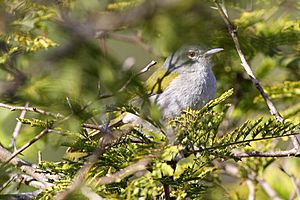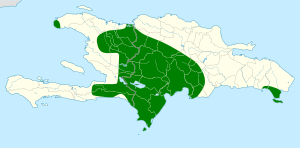Green-tailed warbler facts for kids
Quick facts for kids Green-tailed warbler |
|
|---|---|
 |
|
| Conservation status | |
| Scientific classification | |
| Genus: |
Microligea
|
| Species: |
palustris
|
 |
|
| Range of M. palustris | |
The green-tailed warbler (Microligea palustris) is a small, colorful bird. It's also sometimes called the green-tailed ground-tanager. This bird is special because it lives only on the island of Hispaniola. This island is shared by two countries: Haiti and the Dominican Republic.
Contents
What Kind of Bird Is It?
The green-tailed warbler is the only species in its group, called Microligea. Long ago, scientists thought it was a type of New World wood warbler. But in the early 2010s, new DNA tests showed it wasn't related to those birds at all!
So, in 2017, scientists created a brand new bird family just for it and a few other birds. This family is called Phaenicophilidae. It includes the green-tailed warbler and some birds from the Phaenicophilus group.
There are two main types, or subspecies, of the green-tailed warbler. One is called M. p. palustris. The other is M. p. vasta. Scientists are still studying if there might be a third type in Haiti.
What Does the Green-tailed Warbler Look Like?
This warbler is about 12 to 14.5 centimeters (5 to 6 inches) long. It weighs around 9.5 to 15.2 grams (0.3 to 0.5 ounces). Male and female green-tailed warblers look very similar.
Adult birds have a gray head and neck. They have white arcs around their ruby-red eyes. Their backs are olive-green, and their bellies are pale grayish-white. The M. p. vasta type is usually paler and has more white on its belly.
Where Do Green-tailed Warblers Live?
The main type, M. p. palustris, lives in the mountains of central Hispaniola. These mountains are mostly in the Dominican Republic. They like forests with lots of trees and thick bushes. They can be found high up, even at 2,900 meters (9,500 feet) above sea level.
The M. p. vasta type lives in a separate area. It is found in the dry lowlands of the southwestern Dominican Republic and on Beata Island. Here, they live in dry, scrubby areas close to the sea.
How Do Green-tailed Warblers Behave?
Movement and Daily Life
Green-tailed warblers stay in the same area all year round. They don't migrate to other places.
What Do They Eat?
These birds find their food in plants, especially in thick bushes. They mostly eat arthropods, which are like insects and spiders. They can hunt for food alone, in pairs, or sometimes with other kinds of birds in a mixed flock.
Reproduction and Life Cycle
The green-tailed warbler's breeding season is usually from May to June in the mountains. In the lowlands, it starts a bit earlier. However, scientists think they might be able to breed at any time of the year.
They build a cup-shaped nest using plant materials. In lowlands, nests are often 1 to 2 meters (3 to 7 feet) off the ground, sometimes in cacti. In the mountains, nests can be as high as 10 meters (33 feet). A female usually lays two to four eggs. We don't know much more about how they raise their young.
What Do They Sound Like?
Green-tailed warblers make short, scratchy, and squeaky sounds. These sounds might speed up into what scientists think is their song. Their song has also been described as "sip sip sip."
How Are Green-tailed Warblers Doing?
The IUCN (a group that checks on animals) says the green-tailed warbler is a species of "Least Concern." This means they are not in immediate danger of disappearing. However, their numbers are unknown and seem to be going down.
The biggest problems for these birds are that their homes are being destroyed. Also, introduced animals like the small Indian mongoose might hunt them. Even with these threats, they are still quite common in some areas.
See also
 In Spanish: Reinita coliverde para niños
In Spanish: Reinita coliverde para niños


